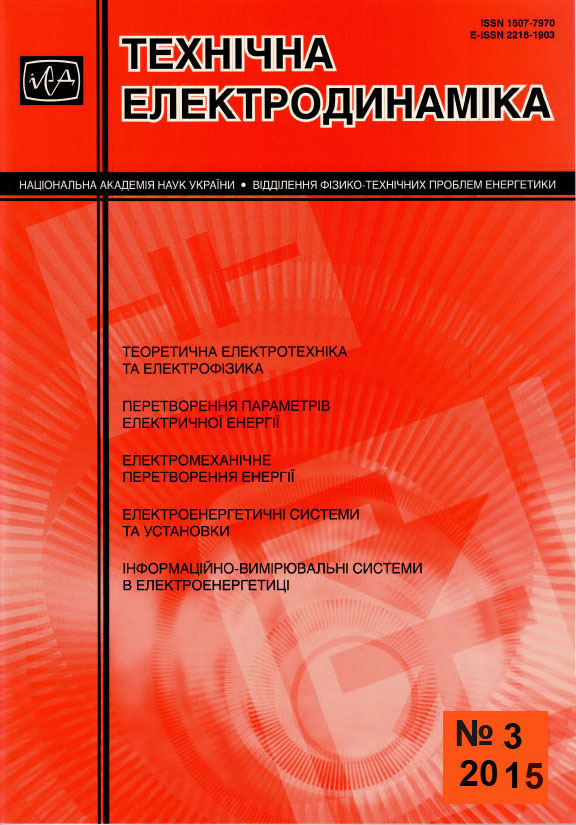Abstract
Energy efficiency of pulse barrier discharge was studied when handling contaminated water in drop state. The study was conducted with three hydrodynamic modes of drops motion, each drop characterized by average drop size diameter of 0,4 mm, 1 mm and 2,5 mm accordingly plus by speed and frequency of dripping. Methylene blue, a persistent organic compound with an initial concentration of 50 mg/l, has served as a water contaminant. Having passed once through discharge camera, decomposition degree of impurities was achieved 40...68 % with the energy yield upto11,3 g/kWh. The drop size diameter and coefficient of the discharge gap filling with drops is ones of the main factors that determines the energy yield of pulse barrier discharge. This coefficient is calculated as the ratio of the total area of all the drops, which are in the discharge gap at the same time, to the area of one of electrodes. For the experimental work conditions this ratio has reached 11,5%. When ratio is reduced to 0,2% the energy yield is down by one order. References 10, table 1, figures 5.
References
Bozhko I.V., Charnyi D.V. A study on effectiveness of water purification from organic impurities by pulse discharges // Tekhnichna Elektrodynamìka. – 2013. – № 3. – Pp. 81–86. (Rus)
Kornev Ya.I. Water Treatment in water-air flow by pulsed discharge. Diss. kand.tekhn. nauk. Tomsk, 2005. 22 p. (Rus)
Yavorovskiy N.A., Kornev Ya.I., Preis S.V., Pelchtsman S.S., Khaskelberg M.B., Chen B.N. Active particles-oxidants in water-air stream // Izvestiia Tomskogo politekhnicheskogo instituta. – 2006. – Vol. 309. – № 2. – Pp. 108–113. (Rus)
Alex Pokryvailo, Michael Wolf, Yankevich E., Wald S., Grabowski L.R., van Veldhuizen E.M., Rutgers W.R., Reiser M., Glocker B., Eckhardt T., Kempenaers P., Welleman A. High-power pulsed corona for treatment of pollutants in heterogeneous media // IEEE transactions on plasma science. – 2006. – Vol. 34. – № 5. – Pp. 1731–1743.
Bo Jiang, Jingtang Zheng, Shi Qiu, Qinhui Zhang, Zifeng Yan, Qingzhong Xue. Review on electrical dicharge plasma technology for wastewater // Chemical Engineering Journal. – 2014. – №236. – Pp. 348–363.
Gao Jin, Gu Pingdao, Yuan Li, Zhong Fangchuan. Degradation of dye wastewater by ns-pulse DBD plasma // Plasma science and technology. – 2013. – Vol. 15. – № 9. – Pp. 928–934.
Ellyana Njatawidjaja, Anto tri Sugiarto, Takayuki Ohshima, Masayuki Sato. Decoloration of electrostatically atomized organic dye by the pulsed streamer corona discharge // Journal of Electrostatics. – 2005. – № 63. – Pp. 353–359.
Monica Magureanu, Daniela Piroi, Nicolae Bogdan Mandache, Vasile Parvulescu. Decomposition of methylene blue in water using a dielectric barrier discharge: Optimization of the operating parameters // Journal of applied physics. – 2008. – Vol. 104. – Рp. 103306 (1–7).
Ryo Ono, Tetsuji Oda. Dynamics of ozone and OH radicals generated by pulsed corona discharge in humid-air flow reactor measured by laser spectroscopy // Journal of Applied Physics. – 2003. – Vol. 93. – № 10. – Pp. 5876–5882.
Tsuomu Kobayash, Taichi Sugai, Taiki Hanga, Yoshi Minamitani, Taisuke Nose. The effect of spraying of water droplets and location of water droplets on the water treatment by pulsed discharge in air // IEEE transactions on plasma science. – 2010. – Vol. 38. – № 10. – Pp. 2675–2680.

This work is licensed under a Creative Commons Attribution-NonCommercial-NoDerivatives 4.0 International License.
Copyright (c) 2022 Array

